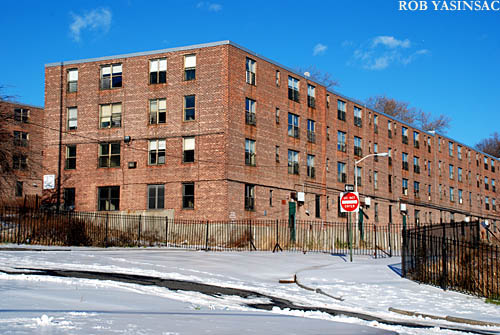
December 2007
MULFORD GARDENS
YONKERS, NY

December 2007
Hailed at its opening in
July 1940 by the United States Housing Authority as a
"symbol of the American way of living," Yonkers' Mulford Gardens
housing project is now
abandoned and slated for demolition, having come in recent years to symbolize
this country for sure - its tale weaving together a number of unsavory threads of
American history that most people would rather ignore than address. Mulford Gardens was
one of several major housing
developments built in southwest Yonkers; in fact, none were built in the eastern
half of the city. This factor caused the city to be cited
in the 1980s by the United States Department of Justice for segregating its
public schools by clustering low-rent housing in one part of the city. To
satisfy the court, Yonkers pledged to build affordable housing units throughout
the city.
Yonkers' largest and Westchester's oldest public housing
project, Mulford Gardens was conceived in the late 1930s. It became reality with
3.4 million dollars, aided in part with federal funding, and ground was broken in
1939.
The apartments replaced "300 ramshackle structures", "substandard
dwellings" on "squalid Mulford
Street." A Housing Authority representative compared the neighborhood
razing and construction of Mulford Gardens to the bombing of European towns,
justifying the reason to destroy and to build anew because it would be better. But municipal
and federal polices in the following decades helped make housing projects like
Mulford Gardens far from the American Dream.
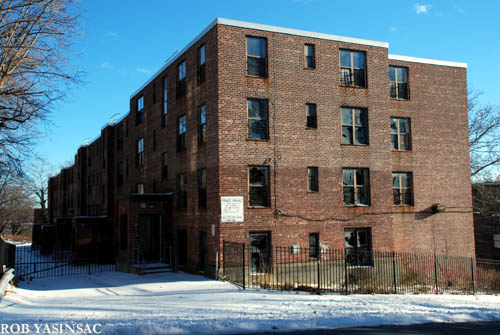
Mulford Gardens took in its first tenants on June 28, 1940.
552 "decent, safe and sanitary" apartments were built into seventeen buildings on the eleven-acre site. 2.5-room apartments rented for
$22.50 monthly at the time of opening; 5.5 room apartments rented for $26.50
(the market rate for a 2 bedroom apartment in Westchester County today might be
around 1500 dollars per month). The rates corresponded
roughly with the maximum income figures of the tenants, relative to
family size. The complex was hailed as "outstanding as a venture of the
United States Housing Authority," owing to fireproof construction that
would restrict conflagrations to the source apartment. Other highlights cited by
the architects were "outdoor play areas for children and six indoor
recreation rooms for adult use for dances, ping-pong and other
entertainments." Much later, tenants kept to their apartments and
shunned these outdoor areas which became drug turf and a magnet for crime.
One
theory of how poor urban planning failed housing projects was that tenants did not
feel a sense of ownership or entitlement over outdoor spaces because all was
held in common (there were no backyards or private front stoops to maintain), thus the insides of their
apartments were tenants' only domains. Even the most
basic accommodations for outdoor socializing, such as benches, were non-existent.
Practices that would ordinarily be tolerated in typical neighborhoods such as
outdoor barbecues, were prohibited. With no concerned eyes around to monitor the
scene, drug-dealers and gang-members took ownership of these outdoor
"anonymous spaces." Yearly felony arrests typically numbered in
double-digits, though such crimes were often committed by non-residents. Despite
all of this, residents interviewed by local newspapers often spoke of a sense of
community, and remembered when Mulford Gardens was more good than bad. (Oscar
Newman was a proponent of urban planning designs meant to replace sites like
Mulford Gardens; his ideas can be found at the Defensible
Space website.)
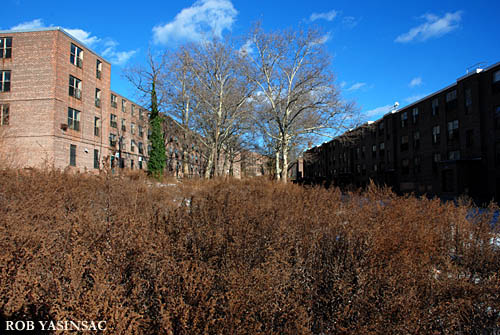
Over time, Mulford
Gardens strayed from the idealized form of the American Way of Living.
The problems of the urban working-class were exacerbated by
economic downturn, which occurred in Yonkers about 15 years after Mulford Gardens opened. Just one block to the east, the giant Alexander Smith Carpet
Mills went silent after the company merged with an upstate competitor and fled
to the South for greater profits. Although the company was doing well financially, the promise of
cheaper labor and subsidized construction of new factories containing the latest
technological advances in machinery was too attractive to turn down.
Good-paying jobs became hard to find in Yonkers and urban centers across America. Many fled
the cities for the suburbs, and those who stayed behind often found it hard to
escape.
Design and construction alone of the Mulford Gardens complex can not be blamed
entirely for onset of squalor in the late 20th century. Similar housing
developments exist throughout Westchester County in places such as
Hastings-on-Hudson, Irvington, and Tarrytown, and these buildings have
"gone co-op" today, with individual units fetching decent sums on the
real estate market. Some who lived at Mulford Gardens have told me that the
decline really began in the 1970s. Previously, there were rigorous reviews and
required references before a family could move in. But troubled brewed to the
south when scores and scores of apartment buildings burned in the Bronx, and
people fled out of that area, many into Yonkers. Less rigid entrance policies at
places like Mulford Gardens followed, as did crime.
The struggles encountered by urban populations in the late 20th century compounded
housing policies set earlier in the 1900s. Federal "Jim Crow" policies made the move
out of the cities and into the suburbs
difficult, if you didn't happen to be white. Suburban developers and
mortgage bankers were allowed by court decisions to set racial restrictions on
housing sales and financial policies, and realtors often steered potential
buyers to certain neighborhoods by their color. Although the modern suburbs were created
with public subsidies and legally-backed racial restrictions, they were
celebrated while public housing and public assistance ("welfare") were
scorned. Remnants of such polices can be seen beyond the housing projects: The historically white Homefield neighborhood
purchased a strip of land around the black Runyon Heights neighborhood and built a barrier (photo
here) separating the two. As the only black
community on the east side of the city, Runyon Heights was and is still today
only accessible via one way in and out of Tuckahoe Road.
(For further reading on this subject,
I recommend Who Do We Think We Are? Race and Nation in the Modern World,
written by Philip Yale Nicholson, regarding federal policies. For more information on the Yonkers
desegregation case, I recommend the book Show Me a Hero by Lisa
Belkin, and the documentary film Brick-By-Brick:
A Civil Rights Story.)
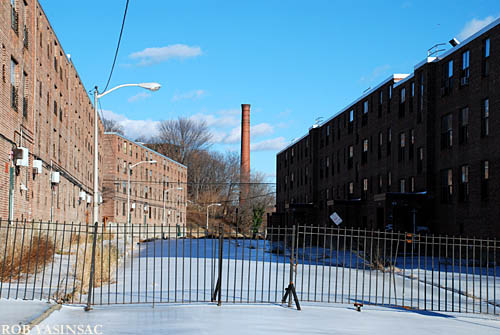
Yonkers
has only recently, after a quarter of a century, officially fulfilled its
obligations to the court and to the NAACP, showing it has built the required number of
housing units throughout the city. Now, Mulford Gardens will be demolished and replaced by market-rate and low-rent units, consisting of
single-family homes, townhouses and apartments. If this plan succeeds, look for
at least three other housing projects to meet the wrecking ball as well. Tied
in is the larger plan to redevelop the Ashbuirton Avenue corridor, to connect
the Saw Mill Parkway and New York State Thruway on the east to the waterfront on
the west, where Yonkers government officials see salvation in each new high-rise
luxury apartment tower sprouting along the Hudson shore (which block the view of
those less fortunate and living literally on the wrong side of the tracks).
In its final years, Mulford Gardens gained a bit of fame when it was used as a movie set for Freedomland,
starring Samuel L. Jackson and Julianne Moore. Yonkers sought
revitalization in earnest in the early 2000s, and Mulford Gardens occupants
began relocating to other housing sites around the city. The last tenant moved out in March 2007.
There are no voices calling for the preservation of Mulford Gardens, although some
may argue that simply replacing the buildings will not solve issues of crime,
drug use, and poverty. But in New Orleans, the National
Trust for Historic Preservation lobbied against the demolition of four housing projects
deemed historic; at another site, several buildings of the St.
Thomas housing project were saved for affordable housing.
Today, cracked windows and dangling satellite
dish receivers
overlook the scene as wrecking crews empty out the apartments in preparation of
demolition. A vibrant mural still pays respect to ten young men who lost their lives
in or near Mulford Gardens, some shot or stabbed to death. The buildings may go,
but the history and lessons learned about our society ought not be
forgotten.
UPDATE NOVEMBER 23, 2009:
Mulford Gardens has been completely demolished. Some rubble still remains to be removed,
while construction crews are grading the now vacant terrain for new development.
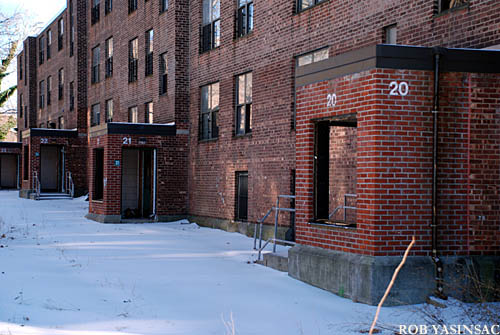
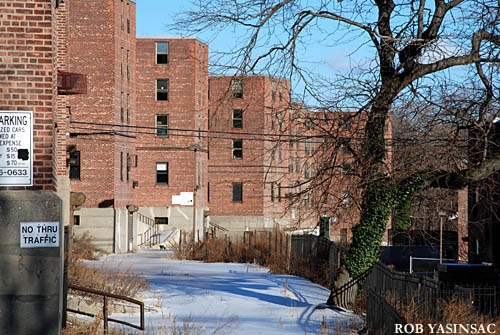
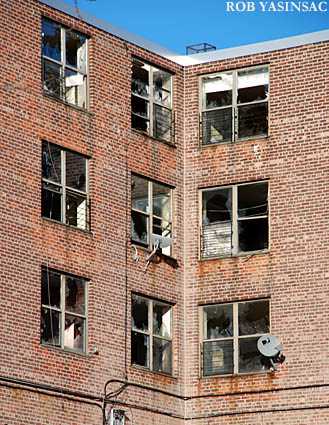
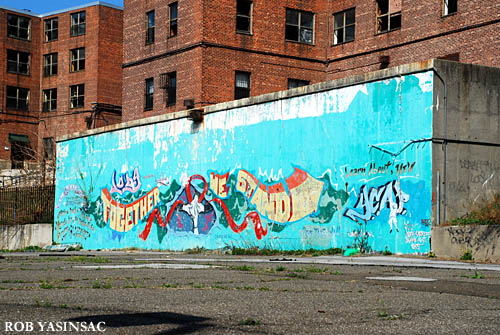
TOGETHER WE STAND
(Photographed April 2008)
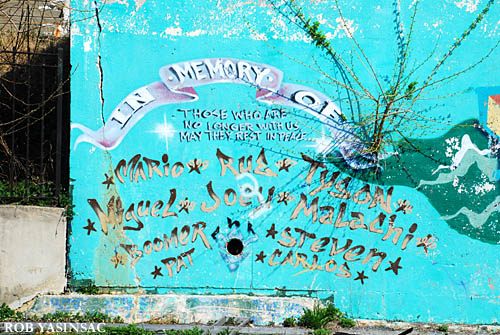
IN MEMORY OF
THOSE WHO ARE
NO LONGER WITH US
MAY THEY REST IN PEACE
MARiO RUE TYSON
MigueL Joey MaLachi
BOOMeR STeven
PAT CARLOS
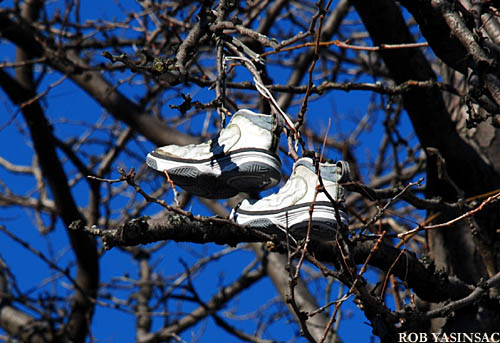
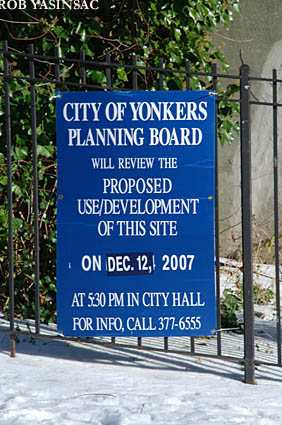
More
Mulford Gardens pictures - Page 2
Yonkers
Ruins homepage
This page copyright © 2008
by Robert J. Yasinsac.
Reproduction or copying of text and/or photography in any form without
permission of the author is not permitted.